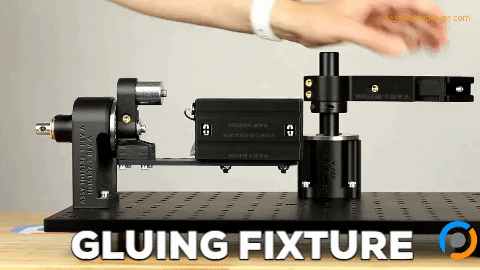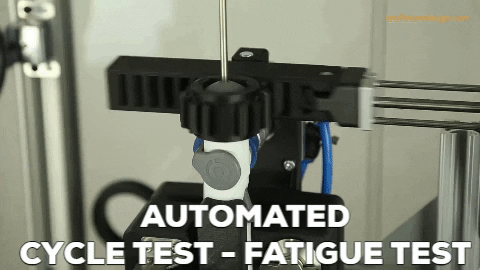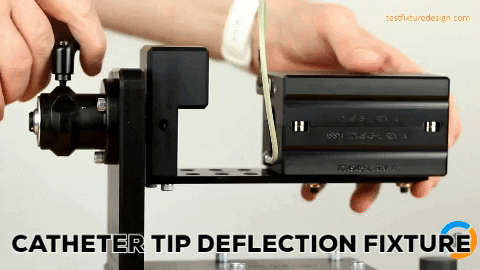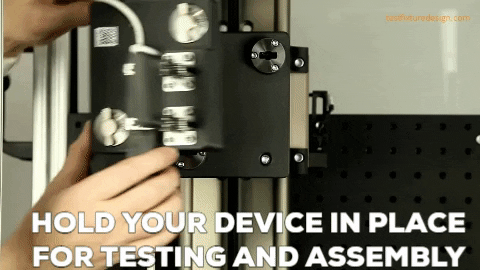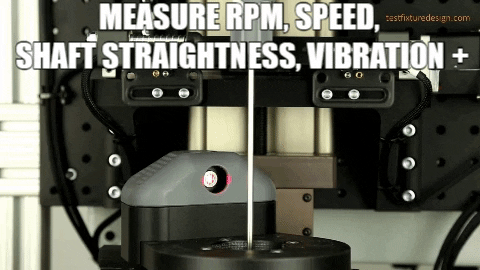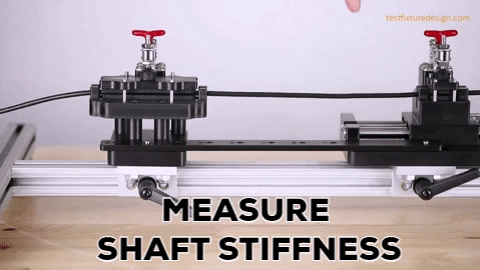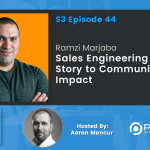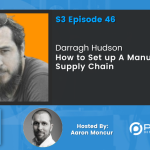Ryan Kircher | Metal Additive Manufacturing
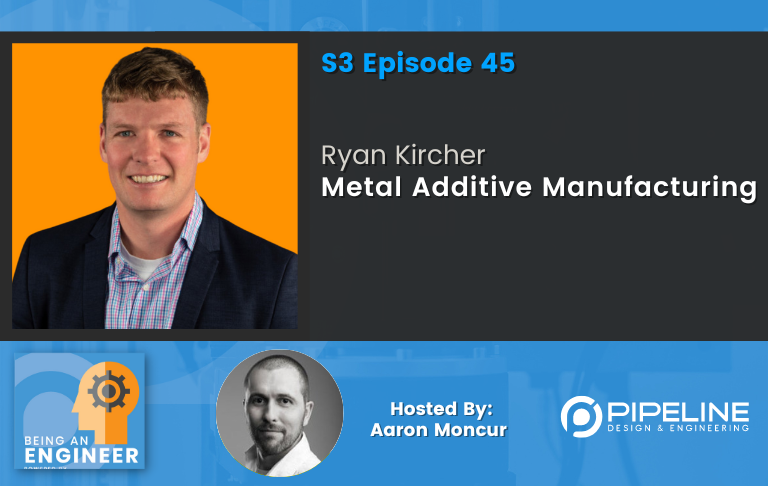
Who is Ryan Kircher?
Ryan Kircher holds both Bachelor’s and Master’s degrees from the Colorado School of Mines in Metallurgical Engineering. He has been working in the Additive Manufacturing industry for many years. He has extensive experience in Medical Devices, Process Validation, Process Improvement, Risk Analysis, Failure Analysis, and Design for Additive as well as Manufacturing Engineering.
Learn more about Ryan: https://www.kircherconsulting.com/
EXPAND TO VIEW EPISODE TRANSCRIPTION
SUMMARY KEYWORDS
additive, metal, powder, engineer, parts, people, lasers, big, print, engineering, ryan, medical devices, process, additive manufacturing, build, industry, systems, work, support, sls
SPEAKERS
Ryan Kircher, Presenter, Aaron Moncur
Aaron Moncur 00:00
Tools education and community to help engineers succeed. That’s the new platform we’re developing called the wave. One of the key features of the wave is called Design Accelerators. These are prepackaged CAD building blocks, similar to the low code, no code trend of the software industry, but for CAD, that help you finish new designs in hours instead of days. Download a sampling of our Design Accelerators for free at Team pipeline.us forward slash wave. And let us know what you think that’s Team pipeline.us, forward slash wave. They’re free, but only for a limited time. So take advantage of this offer and download them today.
Presenter 00:45
Hi, everyone, we’ve set up this being an engineer podcast as an industry knowledge repository, if you will, we hope it’ll be a tool where engineers can learn about and connect with other companies, technologies, people, resources and opportunities. So make some connections and enjoy the show.
Ryan Kircher 01:03
Some of the first metal printers were essentially welders that were put on gantries, or you know, robotic arms and stuff that were basically, you know, automated welders, kind of, like what you’re probably familiar with, like FDM, printing almost, but with metals, right? Instead of extruding polymers you’re, you know, welding from from wires and stuff like that.
Aaron Moncur 01:37
Hello, and welcome to another exciting episode of The being an engineer Podcast. Today, our guest is Ryan chercheur, who holds both bachelor’s and master’s degrees from the Colorado School of Mines in metallurgical engineering. Ryan has been working in the additive manufacturing industry for many years and has experienced in medical devices process validation, process improvement, risk analysis, failure analysis, and design for additive and manufacturing engineering. Ryan, welcome to the show. Thanks so much for being with us.
Ryan Kircher 02:10
Yeah, thanks for having me. I’m really excited to talk with you today.
Aaron Moncur 02:15
Yes, I’ve been looking forward to it as well. So I’ll start off with the same question. I asked everyone in the beginning, what made you decide to become an engineer?
Ryan Kircher 02:23
Yeah, it’s an interesting question. And, you know, I gave it some thought. And I, I don’t really know, you know, I think it was something that just always seemed to fit. Yeah, I have some engineering friends that are like really mechanically inclined, you know, take around cars and stuff throughout high school and all that kind of stuff. I wasn’t necessarily like that. That kind of engineer. I was more just, I loved science and math and physics and things like that. So it just seemed like a natural fit for me.
Aaron Moncur 03:00
At what point did you say to yourself, yep, engineering. First of all, I understand that engineering is a thing. Like that’s a role that I could make a living at. And, and that’s what’s for me.
Ryan Kircher 03:11
Probably when I was, you know, a teenager, probably like, early in high school is kind of when I knew I wanted to be an engineer, I’d say, yeah, yeah.
Aaron Moncur 03:21
You went on to the the Colorado School of Mines. And I’ve heard very good things about that college. What was your experience there? And how well do you think it prepares you for industry?
Ryan Kircher 03:32
Well, I think it prepares you for industry extremely well. It is a unique school. I will say though, so my, my number one piece of advice for anyone considering going there, make sure you want to be an engineer, or, or something very similar, because that’s about all you can study there. They have all kinds of crazy branches of engineering, you can you can study there, you can do explosives engineering, mining, engineering, metallurgical engineering, but it’s a very engineering focused school, which I if I had to make one criticism of it is that it is almost too focused on engineering. So when I got out of college, you know, I’d be talking with friends and stuff who went to other schools, and they would talk about, like, you know, history of art and all these really interesting courses they took, and I didn’t take any of those schools minds, you know, very low interest very, like math and physics, and, and all those types of things, right. Like, I mean, we took we had to take a philosophy class, and it was actually called the philosophy of engineering. So it was like, whether you should build a bridge or a dam or not, and those types of things. So it’s a very focused for years, it’s, it’s pretty challenging to definitely, you know, some hard hard courses and things like that.
Aaron Moncur 04:54
Not a whole lot of arts and humanities, though.
Ryan Kircher 04:57
Not a lot of Arts and Humanities. Not a lot Out of I mean, it’s never gonna win awards for its partying and social aspects either, right? It’s a, it’s a lot of kind of nerdy engineers, right? I actually went there when it had its peak of female enrollment, and that was 30%. And surprisingly, it’s actually gone downhill. Yeah, yeah.
Aaron Moncur 05:22
And you said it was a pretty challenging coursework there, huh?
Ryan Kircher 05:26
Yeah, yeah. I mean, a lot of very bright people go there. And a lot of first semester like that first, like test that we have to take. I think it’s an eye opener for a lot of a lot of students, because a lot of them kind of maybe kind of coasted through high school or didn’t really have good, develop good, like study techniques and things like that. And yeah, it’s after that first, like chemistry test, kids are walking around kind of glazed eyes. Like what just happened? Because, you know, yeah, I definitely had to learn how to become a student much better when I went there.
Aaron Moncur 06:08
You know, I think that’s one of the best things about engineering school in general is it teaches you how to learn and maybe even more so the Colorado School of Mines.
Ryan Kircher 06:18
Yeah, I mean, I definitely took tests, when I was there that the professors would tell you, when they handed out the test, you don’t know enough information to have fully answered some of these questions. I just want to see how far you can get. Yeah, I mean, it really does like force you to kind of try to think and learn and try to solve problems, even when you don’t even know, enough information to fully solve them. So
Aaron Moncur 06:46
yeah, stretch yourself a bit. That’s cool. Well, you’ve been working in metal additive manufacturing for quite some time. Now. I think most engineers are pretty familiar with like polymer based additive manufacturing, 3d printing, but probably a lot of us aren’t super up to date with the current state of the art of metal additive manufacturing, can you just kind of recap where we’ve been in the past 10 years in regards specifically to metal additive manufacturing, and where we are now and kind of what advances that we might look forward to in the next five years or so?
Ryan Kircher 07:23
Yeah, I mean, there’s a variety of just like with other additive techniques, there’s a variety of different techniques that people use to additively manufacture metals. You know, there’s, you know, at a very basic level, you know, some of the first metal printers were essentially, welders that were put on gantries, or, you know, robotic arms and stuff that were basically, you know, automated welders, kind of, like what you’re probably familiar with, like FDM, protein almost, but with metals, right, instead of, you know, extruding polymers you’re, you know, welding from from wires and stuff like that. But I’ve spent the majority of my career in powder bed, fusion type, metal printers, those, there’s, there’s a variety of different ways of doing that as well. But the essential processes, you know, start with some sort of base plate or substrate and distribute a very thin layer of metal powder, and then use an energy source. The two most common are either lasers or electron beams to essentially weld that layer of powder to the substrate, and then the substrate drops, you put down another layer of powder. And you well on top of that, so you just, it’s, it’s so it’s called powder bed fusion, because it’s a powder based process. And, you know, print 1000s of small layers of of that powder on top of each other.
Aaron Moncur 08:50
Sounds a lot like SLS, but with metal.
Ryan Kircher 08:54
Yeah, yep. I think the big distinction there and this wasn’t always the case, but it is primarily the case now is that we’re not necessarily sintering the powder particles together, we are really essentially creating a weld bead right? So that that powder gets turned into a liquid and then solidifies. So you’re getting, you know, fully dense material if it’s done, right. Interesting. Okay. Okay. And then, as far as like advancements right now, there’s kind of an arms race as to who can put the most lasers or maintain the the most well pools at the same time, people are getting pretty creative on how they’re doing that. So that’s kind of where the industry is improving right now. Just trying to put as much energy into that powder bed as possible to speed the process up. Because right now, one of the biggest drawbacks to powder bed fusion is is just takes a long time. Right?
Aaron Moncur 09:51
Give me a sense for how long that takes. Let’s say we’re printing like, I don’t know, a baseball sized part that is not solid. Maybe it’s Like a 30% infill or something, how long does that take to print in metal?
Ryan Kircher 10:04
Like a day, right? But you could probably fill a build platform full of like, I don’t know, 20 or 30 of those, and it might take two or three days. Okay, so there’s definitely like it’s not FDM is kind of really based on how much material you’re laying out. Metal based processes are really kind of driven by how tall the parts are, right? The taller the parts, the longer it takes to build them. Because there’s, there’s a whole step of distributing that layer of powder that you have to do every single layer, so that can start adding up over time. Right? Yeah, like you only drive the build time. Okay.
Aaron Moncur 10:42
And so, metal 3d printing is it takes longer for sure than like FDM, or SLS, but it’s not like 10 times longer, right? It’s I don’t know, two, three times longer if that.
Ryan Kircher 10:55
Yeah. True. That’s an accurate statement, right? I mean, and with with all the lasers and stuff, it’s getting close to, I mean, it could be faster than some of those other additive processes as well, if with some of the newer improvements that people are making, but you know, your competitor, that it’s dealing with this conventional manufacturing, like machining, or casting or something like that, right, can like kind of compete on a on a scalability and efficiency side, like comparison to those types of processes. Right? What a struggle.
Aaron Moncur 11:27
What are some of the biggest limitations right now is I mean, time it sounds like is one is that the biggest limitation? Are there others as well,
Ryan Kircher 11:35
I mean, time and cost, it’s expensive. I mean, the systems that we’re using to do this are expensive, you know, that there’s, there’s some like entry level, like r&d type systems, you can maybe get for $100,000. But, you know, most of like the industrial additive systems we’re using or, you know, $100,000, all the way up to, for some of the ones with multiple lasers, three or 4 million, right. So they’re expensive pieces of equipment that you have to depreciate. And if they’re slow, you know, you might need a bunch of them to be able to make, you know, if you have to make 10,000 parts a year or something like that, all of a sudden, you have to have a bank of the systems, a lot of upfront capital cost. So, it’s other limitations. I mean, there are other metal processes that can make nice little fine, detailed, precise parts. But the powder bed fusion process is kind of limited in its resolution, by the powders that we’re using. And the challenge there is that they need to be able to get distributed well. So like flow ability of the powders, can be challenging. So there’s kind of a limitation on the fineness of powder we can put into the processes, which kind of relates to how the kind of details we can get. And then I think one of the other, I wouldn’t say it’s a limitation, but one of the kind of downsides to metal additive, at least with powder bed fusion, is that any support structures or things like that, that you have to build on to the parts are made out of metal? Right? So remove, just snap them off. Exactly right, they can be really challenging to remove a lot of, you know, manual labor, you know, chisels and flyers and stuff like that. Right. And so, it’s kind of the dirty, dark secret of metal additive, especially like in medical devices, which I’ve focused on a lot. You know, most people that are doing metal additive have a core group of people who who spend their days removing supports off of parts.
Aaron Moncur 13:40
Wow, okay. What are some applications that metal 3d printing can be used for, that maybe a lot of engineers aren’t familiar with or just haven’t had an exposure to,
Ryan Kircher 13:51
um, I always, everyone always wants to like swing for the fences and build like, a bracket to put on a satellite or, you know, a rocket engine or the cool implants and stuff like that. Those are all very high end applications, right. And the testing and qualification or validation, you have to go through to be able to use those parts. is quite extensive, can take years, right. I still think metal additive has a lot to offer in manufacturing tools. Right? Like a really cool application that people are using metal additive four is to make injection molding tools, right. So your ability to put like, conformal cooling channels underneath it inside. An injection molding tool enables you to cool down that tool much faster than you could if you were just like drilling cross holes and stuff like that, which is what people typically have done and still do. And that can have an impact of decreasing The Cycle Time by you know, 20 or 30% or something, you know, taking a couple seconds off of each each shot of the your injection molder, which can have huge, huge payoff, right. Yeah. And at the end of the day, if the tool breaks, you make another one, right? It’s a lot less, a lot more reward for a lot less risk. Right?
Aaron Moncur 15:20
Oh, that’s interesting. I wouldn’t have thought of that. That’s a pretty big part are large parts like that, you know, tool sized parts commonly made?
Ryan Kircher 15:30
Yeah, yeah. I mean, that’s another I mean, we talked about the, the arms race as far as putting more lasers on systems. And it kind of goes hand in hand with the arms race of trying to make bigger and bigger parts, right? Because if you have one laser trying to make a gigantic part, I mean, you’re literally thinking it could, you know, that system could be running for a month. Right. So that that’s why people are putting more lasers on the system has tried to get that build time down to a reasonable number, like a couple of days or even a week. Right? So the biggest systems out there, yeah, they can print things that are like a meter cubed. Now, right? Or even bigger? Some like specialized, gigantic, yeah, mostly, those are mostly being used to, it only makes sense to use a printer that size. If you have to make a part. It’s that big, right? So like what we do with making spinal implants and medical devices, the trade offs, the extra expense and difficulty of using multiple multi laser systems with big platforms just isn’t there. So we still like to use the small ones. They’re more agile, more predictable, simpler.
Aaron Moncur 16:36
How about the the surface finish? I mean, you talked about using these to make molds, but on a mold, you have to have pretty nice surface finish. And last time I checked, which admittedly was several years ago, the surface finish on metal additive is kind of rough. Is that just you have to go through a post processing phase and buff that out. Yep,
Ryan Kircher 16:55
exactly. Right. Almost. I mean, it depends on what you’re what you’re trying to accomplish, like some of the medical devices that we make people like that rough surface, right, because bone actually likes that rough surface. So you know, in those situations, that rough surfaces is one of the reasons people are using additive. But almost everything we make, at RMS, we go and machine or finish surfaces that need to have a higher finish, right? If they’re mating surfaces, things like threads, things are going to get laser marked or labeled or something like that. So almost everything we make in our additive systems actually goes into a CNC mill.
Aaron Moncur 17:32
Okay, Okay, interesting. Can you give us I don’t know, if there even is a kind of a rule of thumb for for cost of making metal additive parts. If you’re gonna make a part metal additive, versus the same part out of like a die casting or machining operation? How do those how do those compare,
Ryan Kircher 17:55
I used to have a rule of thumb that if you can make it another way, it’s probably going to be cheaper. Ultimately, so it’s expensive, right? We’re making one product right now that is actually proven me wrong, it’s like a, it’s a titanium, thin walled housing for medical device instrument. Where it’s, you know, the bar stock that you need to use is, you end up throwing away 90 some percent of that bar stock to get to the right. And titanium is an expensive material. So that’s the one case where it’s actually more cost effective to use additive, but in general, you know, if you can make it another way, it’s likely going to be more economical right now, there are some other metal processes coming up like binder jet printing that maybe are changing that those those systems can you know, maintain 10 1000s of parts a day. So, the economics there are are pretty lucrative, right? The automotive industry is finally starting to look at added metal additive, because of binder jet printing, because it is high throughput and low cost. But like powder bed fusion is is pretty pricey. So when it comes to trying to decide when and how to use metal additive, unless the part is designed with some sort of extra value in it, that can only be manufactured through additive. The economics usually aren’t going to work out.
Aaron Moncur 19:30
Got it. Okay. How about designing for metal additive? Is it fundamentally the same as designing for, you know, like polymer based 3d printed parts? Are there any special best practices to follow?
Ryan Kircher 19:44
It’s similar, right? It’s mostly I would say it’s mostly similar to FDM. Right? So the tricky thing with there’s there’s tricky the tricky thing with metal additive is is that it’s a pretty hot process. So you have to support parts. And you have to support parts for usually one of two reasons. When you’re using metal additive one, you have these down facing surfaces like you, like you have an FTM, right? Like, you’re just fighting gravity, you gotta have something there to support it, the powder bed itself isn’t necessarily enough support. So you have those kinds of supports that are just basically scaffolding and stuff to kind of give you a platform to build on top of. But then you also have what we love people call solid supports. And I like to consider those more like anchors, right? Those are there to actually hold the part in place, because it gets so hot when you’re printing certain areas that you build up a lot of residual stresses in the park to work outside of the build plate crack all kinds of things, right. So there are some additional, like support strategies, things you have to take in consideration when designing for metal additive. And all of those are things you got to go remove, right. So a big thing in metal additive is trying to figure out how to build the parts without any supports. Right, so that comes down to certain geometries that can print Well, certain angles that you have to avoid and things like that. And then the industry is getting really creative with different processing parameters, maybe scanning a layer with less less power, and then coming back and, and then welding it. And the whole goal there is to kind of develop what people are calling like support lists, processing parameters that allow you to open up that design space. So you can print geometries that typically would have required supports, without support. So that’s kind of a big from a software and like, process standpoint, that’s, that’s like a big area of focus right now in the metal additive.
Aaron Moncur 22:02
So I thought I thought that, I’m just gonna go back to the pseudo analogy of SLS, because that’s what I know, I don’t know metal, hardly at all. But in SLS, you don’t really need supports at all, I thought that the powder based metal additive was a pretty similar process fundamentally, but it sounds like that’s not the case.
Ryan Kircher 22:25
Not the case. Definitely not the case. Just because of the the warping and residual stresses. And it’s not, like I said fighting gravity, that’s not really the right word, it’s more you want to try to keep it in place, you got to hold it in place and wants to come popping out of the bill plate and working up, you know, potato chips, and things like that, right. And then the problem is, is then it comes in, destroys or hits the the rake or distribution arm that you’re using to move the powder around. And then okay, bad things happen.
Aaron Moncur 22:55
So it does look like a bit of powder as an SLS, but the like the thermal stresses going on are so intense that this thing is just moving around a lot more than like a polymer part would remove. Yep. Okay,
Ryan Kircher 23:09
got it unless it’s held in place. Absolutely.
Aaron Moncur 23:11
Yeah. All right. How about the purity of the final product, I mean, if you print something out of titanium is it going to be like pure titanium or there’s some kind of fillers that are part of that powder that that end up in the product as well.
Ryan Kircher 23:24
So, as far as powder bed fusion, you know the the laser based in the electron being melted, the electron beam based processes, you know, what you put in is more or less what you get out right there are some intricacies to that because you are creating a whirlpool just like in welding processes and stuff like that you got to use shielding gases right. And the shielding gases are there for a couple of reasons. One is that they do maintain the chemistry of that metal powder when it’s you know, in its liquid form, you know, prevents it from picking oxygen and stuff up from the air, but they also move spatter and debris away from the Whirlpool too. So generally, most metal based powder processes have argon or nitrogen gas that’s introduced and then actually pushed either through fans or manifolds or something like that across the build plate. So so if you ever looking in the metal additive system, usually you can kind of see like a plume of smoke and debris kind of getting pushed into the back or the side of the machine out of the way.
Aaron Moncur 24:36
I hadn’t even considered that before. So the the, what did you call the gas shielding? That shielding? shielding gas, okay, is that that’s just to create a barrier around the parts so that it doesn’t oxidize or start corroding? Yep, that that’s what that
Ryan Kircher 24:55
end and move the debris and stuff away from that debris. Well or detract from the laser or electron beam, right? So, okay. I mean, they kind of do different things in the two processes. electron beam melting is typically done under a relatively high vacuum, because even argon gas, I mean, it’s basically electrons, you know, flying from the top of an electron gun down into the powder bed. So they’ll get distracted by essentially anything so that that process is actually done under a high vacuum, but just a small amount of helium, actually, because they have to use a really light gas so that it doesn’t detract from the energy.
Aaron Moncur 25:30
Well, I’m starting to realize why some of these machines are upwards of a million dollars. There’s a lot going on,
Ryan Kircher 25:35
right? Well, I mean, the shielding gases can get expensive, too, right?
Aaron Moncur 25:38
Yeah. Okay. Yeah, that’s just another consumable, I suppose. Right? All right. Well, let’s, let me take a very short pause here and share with the listeners that teen pipeline.us is where you can learn more about how we develop medical device and other product engineering or manufacturing teams developed turnkey equipment, custom fixtures and automated machines to characterize, inspect, assemble, manufacture and perform verification testing on your devices. We’re speaking with Ryan Carter today, Ryan? So we talked a little bit about the cost for metal additive machines anywhere from like, $100,000, up to several million dollars. How about the space? I mean, there’s obviously a capital investment that goes into there, but how much space do these things take up?
Ryan Kircher 26:27
A lot, a decent amount, right. And it can vary from machine to machine quite a bit, too. And then I mean, it’s not just the printer, you got to have equipment to, you know, receive and reprocess your powder to get it ready for the next build. You got to have somewhere to take the you know, the parts off the build plate and all that. So it takes up a lot of space. I mean, the printers that we use, at RMS probably take up probably like a five foot by five foot area.
Aaron Moncur 27:00
Right? Are they?
Ryan Kircher 27:02
Those systems are probably 10 feet 12 feet tall. Okay, wow. Yeah, that’s definitely heard about several situations where people have bought a metal additive system, and then have not been able to get it into their lap. Because
Aaron Moncur 27:19
yeah, 10 double doors have been removed? Geez. Yeah, it’s a lot cheaper that point probably to remove the door than it is to send the equipment back.
Ryan Kircher 27:28
You know, most of them have vacuum chambers, or, or something else, too. So I mean, big, big chunks of metal too. Right? So yeah, heavy, a lot of times people have to worry about the floors that they’re getting put on, as well. So
Aaron Moncur 27:44
medical is one of the primary industries in which metal additive is being used for like orthopedic implants, especially with the rest surface area that facilitates bone growth, things like that. Are there other industries where you’re seeing a lot of success with metal additive?
Ryan Kircher 28:02
I think one of the probably like, the cooler applications, that’s getting a lot of press and stuff right now, space exploration, right. So one of the one of the nickel based alloys are actually relatively weldable, and a really good fit for metal powder, bed fusion, so and they’re used a lot in, you know, in some pretty high temperature applications. In, you know, rocket engines and stuff like that. So you’re seeing a bunch of those types of companies even like small little startup companies that are creating launch vehicles and, and other things like that, latching on to additive for their ability to make some pretty impressive components that you know, big, and very intricate, you know, with all kinds of conformal channels through them and things like that.
Aaron Moncur 28:56
Yeah. What’s the biggest metal additive part you’ve seen made? Oh,
Ryan Kircher 29:03
I mean, pretty big. I mean, the biggest parts I’ve seen are made aren’t made in powder bed fusion, they’re typically made with that. Well, like that welding process I was talking about, which we call directed energy deposition DVD, you know, where you’re basically using a wire welder on a gantry or a robot. I mean, some of those parts, you know, can fill fill a room. They’re pretty big.
Aaron Moncur 29:29
What kind of part is that? That would fill a room.
Ryan Kircher 29:31
So I worked at Lockheed Martin for a handful. I wouldn’t say a room. I mean, I worked at Lockheed Martin for a couple years and they were making, you know, like, fuel tanks. With with a DD type process. I mean, some of those had diameters of, I don’t know, probably four or five feet, at least, right. Really cool application, replacing some really expensive like castings and Four and 14 type process, you know, products that had like lead times of a couple years. So they’re using additive because it cut down on delivery time. Right?
Aaron Moncur 30:10
Wow, that’s really cool. Well, let’s see. So we’ve dug in deep to metal additive. And that’s been super interesting. But I also wanted to touch on the fact that you run your own consulting business on the side. And I’m curious to learn a little bit about how that started. And kind of what your what your focus is there is it also metal additive.
Ryan Kircher 30:32
It I mean, to be honest with you, I do have a consulting company, it’s kind of in a what I would call kind of a dormancy Stage I, I work full time for RMS company right now. So it’s mostly kind of a side project, kind of a side hustle, where I only do certain projects. But basically the goal of kind of, you know, networking, working with some colleagues in the past and stuff, so I’m kind of picky about the projects that I work on. It’s mostly stuff that is just super interesting to me, or people I like to work with. So I only find time to do it. I also have like a, an infant daughter. So I’m balancing a full time job plus hers and Neff. So the consultants kind of taken a backseat over the last couple of days. I started about four years ago. And that was my full time job for about a little over a year. RMS company was one of my customers, and I just really enjoy working I really enjoyed working with them. And the list of projects that we had to work on was so large that they’re like, why don’t you just come work for us full time RMS company is based in northern Minneapolis. And I live in Colorado. And it’s, it’s a giant machine shop, right? We have 700, CNC mills, 30, additive printers. So the concept of like, somebody working remotely for a big machine shop was kind of laughable three years ago, right. But that pandemic was theirs. For me, if there was a bright side of the pandemic, it’s that, you know, it made it you know, fathomable that I could work for RMS remotely, and it’s been working out really well, for me, I really like it. So, but before that I was doing the consulting full time. And it was, I always, if anybody would ask me, like, 1015 years ago, like, what do you want to do with your life? I always told them, you know, eventually, I’d like to just be a consultant and do my own consulting thing. I’m not sure if I feel the same way anymore. It’s, it can be kind of stressful, what’s changed? Well, I’ve only I mean, I don’t need to tell you, but like, you know, owning owning your own company comes with a lot of other baggage, I guess you could say, you know, yeah, yeah, during the financial part of it, you know, I had to do things like get insurance, just a lot of things to learn, you know, it’s half running a company and half doing what you’re supposed to do, right. So your takes a lot of time just to have the company, you know, set up and doing all that kind of stuff. So, you know, you don’t have as much time left over to do the actual consulting, which is where he make your money. And yeah, and I don’t know, for me, it was a hard balancing act with with trying to keep a workload that was manageable, but also ensure that I had work in the future. Right. So it was this, and most people want, you know, if they’re interested in talking to me about consulting, it’s, they have a problem they want to solve now, right? So it was hard, you know, you had to turn people away, because you were too busy to, to do the project for them immediately, and they weren’t really interested in waiting six months to do it. So they’d have to go find something else to do, you know, some other solution. So I kind of had to, like, manage it, like kind of like an investment portfolio I had like, like, not necessarily the highest paying consulting gigs, but ones that were, you know, either like retainer type things, or like a consistent 10 or 15 hours a week that I knew I was going to have for six months. But then I’d have to keep some time open so that I could, you know, do a, you know, something at the last minute, you know, stop what you’re doing and work on this relatively full time for a week type thing. So it was just kind of this balancing act. And it can kind of be stressful, you know, for sure, and not knowing if you’re gonna have any work in six months.
Aaron Moncur 34:42
Yeah, I know what you’re saying all too well. Someone told me a long time ago. This was at the point where I was starting to hire people, but I was still also doing a lot of the work myself as well. And I was I think I was probably complaining to some I’m gonna say I really need to focus on building the business, but I can’t because I’m spending so much of my time actually doing the work, you know. And it was suggested to me that, you know, a lot of times what happens is the owner kind of stops doing the the tactical work and just focuses on building the business. And that’s one solution. But another solution that isn’t so common or popular is that you could hire a president to run the business, so that you can spend most of your time like, you know, working in the technical area of the business. And I thought that was a really interesting approach that I never would have thought of myself. Turns out, I kind of like working on the like, building the business side. So it’s worked out well, for me, but for others who might be listening to this, that that is an option, just hire someone to run the business. So you can work in the technical side within it.
Ryan Kircher 35:49
Yeah, I mean, I, before I was doing consulting, I was kind of in a director, manager role of a team of engineers. And I think, you know, that role plus, the consultants helped me kind of realize that I really like being an engineer. Yeah. You know, and like, when in college, someone told me that, you know, like, 75 to 80% of engineers aren’t actually doing engineering after like, you know, five years or something in the field, there’s a manager or something else, or whatever. I guess I’m one of those rare exceptions. I, whenever I have a performance review with my boss, he’s like, What do you like? What do you see yourself in, in the future? And I’m like, you know, at Lockheed Martin, they had a phrase for an individual contributor, right. It’s, everyone’s always trying to force you up into management roles and all that kind of stuff. Right. And that’s kind of I don’t know, I think we’ve been kind of programmed to think that like, if you’re not getting, if you don’t have manager, director or whatever, in your title, that you’re not success, you know, you’re that’s kind of the label of success. Right. So, yeah, you know, they have this other track, that’s for the individual contributor, the guy who just wants to be an engineer for his. Yeah, you know, yeah. And it’s weird. It’s kind of seen with like a, you know, kind of like a, I don’t know, it has a stigma to it almost. I
Aaron Moncur 37:12
agree. 100%. Totally okay, with it. Unfortunate that that stigma exists, I think, but I think that’s like a totally, very respectable and honorable approach to being an engineer is to just be like, a really good engineer. And that’s what you do for your whole career. That’s great. There’s nothing at all wrong with that, frankly, I think that we need more of that that type of role, because a lot of engineers they get promoted to being a manager. And oh, turns out you’re not a great manager. But I mean, are there any ways
Ryan Kircher 37:43
most engineers I know, have like horrible, like, emotional EQs? You know, like, you’re
Aaron Moncur 37:49
not well suited group of people to be managers?
Ryan Kircher 37:54
Yeah, I was, I remember sitting in a leadership training course. And they kept using the word empathy, like, you need to have empathy for all your employees and stuff. And I mean, that don’t hope, hope this doesn’t make you sound like a horrible person. But I was like, I just don’t know if I’m really capable of having genuine empathy for a bunch of people. I, yeah, I work. And I guess I don’t expect people to have a lot of empathy for me either. You know, like I, I’m a little old, I guess. But you know, work to me a little. I think the workplace is definitely kind of changed over the last 20 years. But you know, I’m one of those, like, go there, get my work done, and maybe have a couple friends at work. But, yeah, it’s kind of
Aaron Moncur 38:37
Yeah, yeah. I think. Had it not been for marriage, my level of empathy would probably be even lower than it is today. Oh, yeah. A lot more in marriage about that than at work.
Ryan Kircher 38:51
And then yeah, having a kid that really changes you to it. Maybe that’s part of the reason is that I never had kids until just recently. So, you know, when I was 2030, and stuff like that. I never really developed those skills. I don’t know.
Aaron Moncur 39:08
Well, you’ve got a wild ride in front of you. I’m sad
Ryan Kircher 39:10
for you been a wild ride already. So exciting. All right. Well,
Aaron Moncur 39:14
Ryan, anything else that you think we should cover that that we haven’t hit on yet?
Ryan Kircher 39:19
I’m not really. I don’t know. I would say like one thing that like I’ve kind of also realized over the last couple of years that that’s kind of a shift is that earlier in my career, which I think is perfectly fine. I wanted to like learn everything and be like, I want to know about every single additive manufacturing process and all the different metals all the different applications and stuff and I wanted to you know, understand the aerospace industry, the medical device industry, the industrial industry, all that stuff. And have kind of kind of come full circle clay started in additive making medical devices and then it kind of branched out and all this other stuff. And I’ve realized recently that, like, I think I’m perfectly okay. Being trying to be at least really good at making medical devices with additive. It’s kind of I don’t know, like, to me, it seems like maybe I’m not branching out enough anymore. But I don’t know, I think a lot of people these days like to keep moving careers and doing different things and stuff. And I don’t know, I’ve kind of come to terms with that. And I like just kind of focusing on trying to do one thing really, really well.
Aaron Moncur 40:36
I think that’s great. Yeah, no, it makes total sense to me. I agree with that philosophy. There’s a quote I have on my wall by I think it’s the author, Ben Hardy, I think, deep work the author of that deep workbook. And it says, I’m not sitting in my office right now. So I might butcher it a little bit. But basically, it says, successes is easy. It’s all about taking 20 steps in one direction. Most people take one step and 20 directions, which I think gets to the heart of you know what you’re saying, get really good at it one thing and do that thing. And everyone’s different, you know, some people would maybe prefer to know a little bit about a lot of things, but I think there’s just a lot of value in being really good at one or two things.
Ryan Kircher 41:21
Yeah, I think I’m just like, naturally very curious. I just want to I always kind of want to learn about everything else. But yeah, just trying to focus on one particular thing is what I’m at least working on right now. So
Aaron Moncur 41:32
yeah. Great. Well, Ryan, thanks so much for for joining me today. I sure appreciate it. How can people get a hold of you?
Ryan Kircher 41:41
I, you can look me up on LinkedIn. Ryan Crutcher. And I know there’s some other rain creatures out there in the world. But I think I’m the only engineer that I’ve been able to find so far. So I think you’ll Yeah, that’s probably the easiest way LinkedIn.
Aaron Moncur 41:57
Perfect. All right. Well, Ryan, thanks so much. Appreciate your time with me.
Ryan Kircher 42:02
No problem. Thanks.
Aaron Moncur 42:06
I’m Aaron Moncure, founder of pipeline design, and engineering. If you liked what you heard today, please share the episode. To learn how your team can leverage our team’s expertise developing turnkey equipment, custom fixtures and automated machines and with product design, visit us at Team pipeline.us. Thanks for listening
We hope you enjoyed this episode of the Being an Engineer Podcast.
Help us rank as the #1 engineering podcast on Apple and Spotify by leaving a review for us.
You can find us under the category: mechanical engineering podcast on Apple Podcasts.
Being an Engineer podcast is a go-to resource and podcast for engineering students on Spotify, too.
Aaron Moncur and Rafael Testai love hearing from their listeners, so feel free to email us, connect on Facebook, Twitter, Instagram, and subscribe on Apple Podcast and Spotify!
About Being An Engineer
The Being An Engineer podcast is a repository for industry knowledge and a tool through which engineers learn about and connect with relevant companies, technologies, people resources, and opportunities. We feature successful mechanical engineers and interview engineers who are passionate about their work and who made a great impact on the engineering community.
The Being An Engineer podcast is brought to you by Pipeline Design & Engineering. Pipeline partners with medical & other device engineering teams who need turnkey equipment such as cycle test machines, custom test fixtures, automation equipment, assembly jigs, inspection stations and more. You can find us on the web at www.teampipeline.us
You’ve read this far! Therefore, it’s time to turn your headphones up and listen now to this episode to learn all these. Don’t forget to tell your friends who might like this too!





